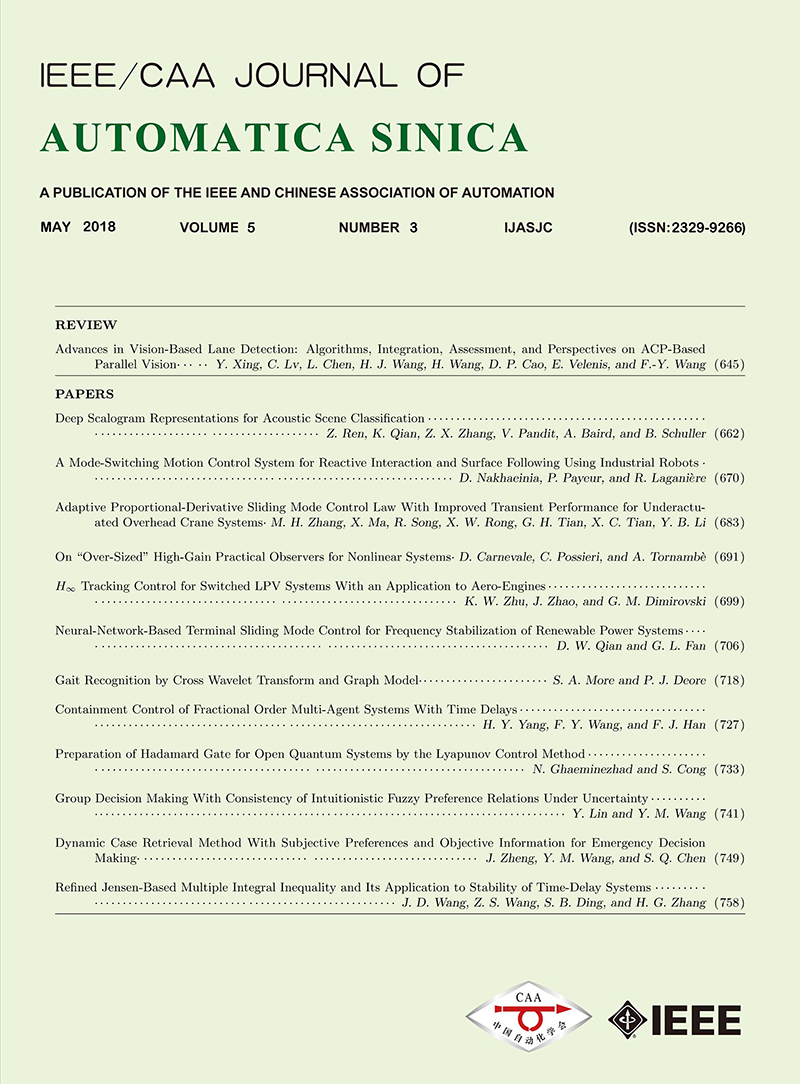 Volume 2
Issue 3
Volume 2
Issue 3
IEEE/CAA Journal of Automatica Sinica
| Citation: | Zhixin Liu, Yazhou Yuan, Xinping Guan and Xinbin Li, "An Approach of Distributed Joint Optimization for Cluster-based Wireless Sensor Networks," IEEE/CAA J. of Autom. Sinica, vol. 2, no. 3, pp. 267-273, 2015. |

| [1] |
Wang H, Yang Y H, Ma M D, He J H, Wang X M. Network lifetime maximization with cross-layer design in wireless sensor networks. IEEE Transactions on Wireless Communications, 2008, 7(10), 3759-3768
|
| [2] |
Liao S B, Yang Z K, Cheng W Q. Joint power control and rate adaptation for wireless sensor networks. Acta Electronica Sinica, 2008, 36(10), 1931-1937
|
| [3] |
Chen J M, Yu Q, Chai B, Sun Y X, Fan Y F, Shen S. Dynamic channel assignment for wireless sensor networks:a regret matching based approach. IEEE Transactions on Parallel and Distributed Systems, 2015, 26(1), 95-106
|
| [4] |
Cimatti G, Rovath R, Setti G. Chaos based spreading in ds-uwb sensor networks increases available bit rate. IEEE Transactions on Circuits and Systems-Part I, 2007, 54(6), 1327-1339
|
| [5] |
Reena J L. Joint congestion and power control in uwb based wireless sensor networks. In:Proceedings of the 32nd IEEE Conference on Local Computer Networks. Dublin, Ireland:IEEE, 2007, 911-918
|
| [6] |
Zhao X J, Zhuang Y, Zhao J, Xue T T. Adaptive power control strategy for wireless sensor networks. Journal of Electronics and Information Technology, 2010, 32(9), 2231-2235
|
| [7] |
Chen H B, Tse C K, Feng J H. Impact of topology on performance and energy efficiency in wireless sensor networks for source extraction. IEEE Transactions on Parallel and Distributed Systems, 2009, 20(6), 886-897
|
| [8] |
Younis O, Krunz M, Ramasubramanian S. Node clustering in wireless sensor networks:recent developments and deployment challenges. IEEE Network, 2006, 20(3), 20-25
|
| [9] |
Liu A F, Zhang P H, Chen Z G. Theoretical analysis of the lifetime and energy hole in cluster based wireless sensor networks. Journal of Parallel and Distributed Computing, 2011, 71(10), 1327-1355
|
| [10] |
Heinzelman W, Chandrakasan A, Balakorishnan H. Energy efficient communication protocol for wireless microsensor networks. In:Proceedings of the 2000 International Conference on System Sciences. Hawaii:IEEE, 2000. 4-7
|
| [11] |
Zhang D, Zhou J, Guo M, Cao J, Li T. TASA:tag free activity sensing using RFID tag arrays. IEEE Transactions on Parallel Distribution System, 2011, 22(4), 558-570
|
| [12] |
Khalil E A, Attea B A. Energy-aware evolutionary routing protocol for dynamic clustering of wireless sensor networks. Swarm and Evolutionary Computation, DOI:10.1016/j.swevo.2011.06004, 2011.
|
| [13] |
He J P, Cheng P, Shi L, Chen J M, Sun Y X. Time synchronization in WSNs:a maximum-value-based consensus approach. IEEE Transactions on Automatic Control, 2014, 59(3):660-675
|
| [14] |
Zhang D, Guo M, Zhou J, Kang D, Cao J. Context reasoning using extended evidence theory in pervasive computing environments. Future Generation Computer Systems, 2010, 26(2):207-216
|
| [15] |
Shu T, Krunz M. Coverage-time optimization for clustered wireless sensor networks:a power-balancing approach. IEEE/ACM Transactions on Networking, 2010, 18(1):202-215
|
| [16] |
Liu Z X, Zheng Q C, Xue L, Guan X P. A distributed energyefficient clustering algorithm with improved coverage in wireless sensor networks. Future Generation Computer Systems, 2012, 28(3):780-790
|